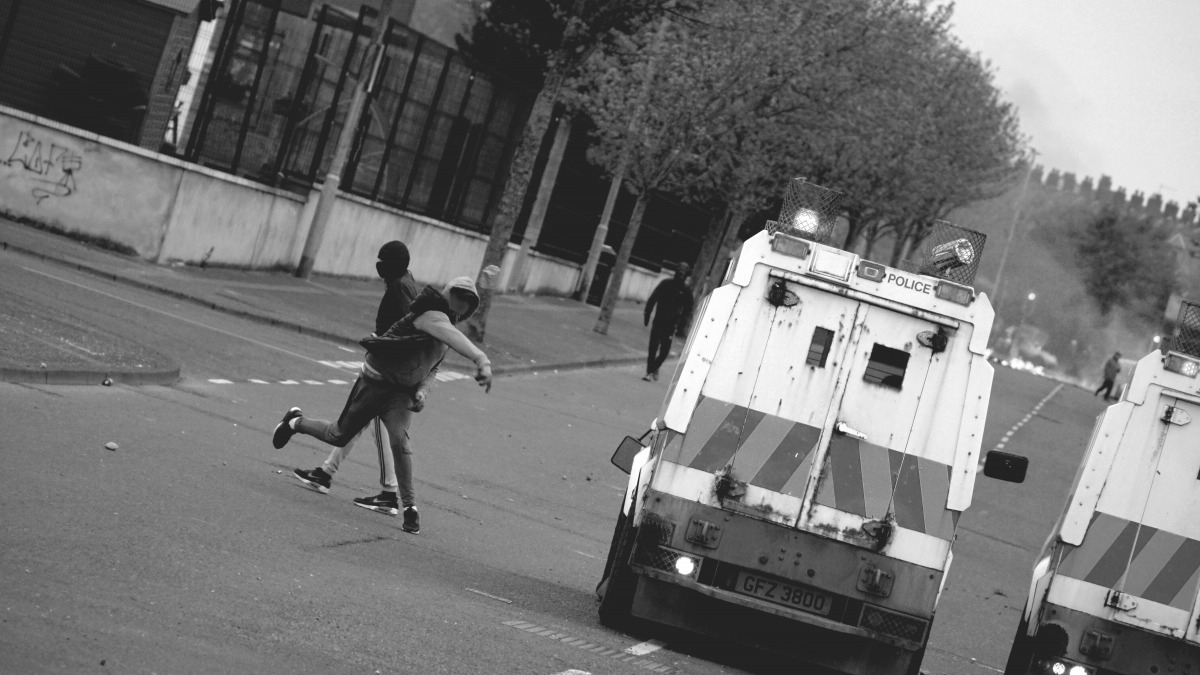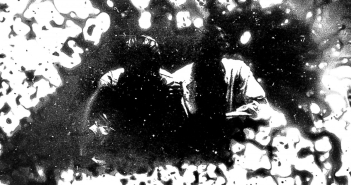There is a strong impression of the same old story of the Troubles in Belfast, all over again. The new element is the pandemic affecting teenage lives. Words and images by Fellipe Lopes in collaboration with Daniele Idini.
It is hard to see a purpose behind the recent violent protests in Belfast that have fleetingly come to global prominence. On the ground, community leaders identify continuities, as recreational rioting is all too familiar, ever since the Good Friday Agreement of 1998.
There is, however, a perception that the intensity of this year’s disturbances are a product of uncertainties around the new Irish Sea border and Northern Ireland’s position in the post-Brexit context.
Brexit has clearly increased insecurity in the Unionist or Loyalist community, many of whom voted against withdrawal from the EU. Now the establishment of a commercial border between Northern Ireland and the rest of the United Kingdom, through the Northern Ireland Protocol, designed to protect the Good Friday Agreement, has created a sense of betrayal. This has hardened the rhetoric of struggle and conflict.
The Unionist side of the argument is that this creates further distance from the rest of the U.K. amidst a sense that they are the ones being sacrificed in the divorce from the E.U.. Moreover, talk of a possible United Ireland in the South and persistent grievances over the failure to prosecute senior Sinn Féin politicians for a perceived failure to abide by social distancing rules at the Bobby Storey funeral fans the flame.

© Fellipe Lopes

© Daniele Idini
Added to all this, Northern Ireland’s lockdown has affected the lives of young people in particular: directly through extended school closures, and loss of job opportunities, but also by creating a despondency that leaves many feeling they have little to lose.
Finally, the long-standing educational segregation between Catholic and Protestant communities perpetuates a sense of “us” and “them.”
So, how to explain these violent outbursts? What is different now from the usual activities? And what role has the pandemic played, especially on the youth involved? We spoke to a politician John Kyle, an activist Eileen Weir and an academic Dr Katy Hayward to find out more.

John Kyle (PUP). ©Fellipe Lopes
According to John Kyle, a Councillor on Belfast City Council, and former interim leader of the centre-left ‘Loyalist’ Progressive Unionist Party in Northern Ireland:
| “There are different factors involved. The first is that young people have been restricted. They have been unable to go to school, unable to meet with their friends, unable to go to the movies, unable to do, you know, stuff like that. If then there’s an opportunity to go out and get a bit of excitement, they will take that opportunity. Secondly, here in Northern Ireland, there is a tradition of what we call recreational rioting. In other words, if there were kids at an interface between two communities in the summer nights, sometimes, they arrange on Facebook to meet up for a fight. And so you might get 100 kids, sometimes 30, sometimes 50 kids. They meet up, start shouting at each other and throwing stones and bottles. And that’s what we call recreational rioting.” |

Daniele Idini with John Kyle. © Fellipe Lopes
But Dr Katy Hayward, an academic and writer based at Queen’s University in Belfast says:
| “Something different has happened in the past few weeks, and that is that you’ve had a change in the political situation whereby the rhetoric in particular, from Unionist communities, and leaders has been one in which people have begun to really, doubt the process of basically the core elements of the Peace Process, for a long time. And amongst Loyalist communities, there has been a sense of frustration and anger about the Good Friday Agreement and compromises there. This is now beginning to get into the wider mainstream political field. And that’s primarily as a result of the conditions of Brexit, also you’ve had a new dimension, which is the criticism of the police service” |
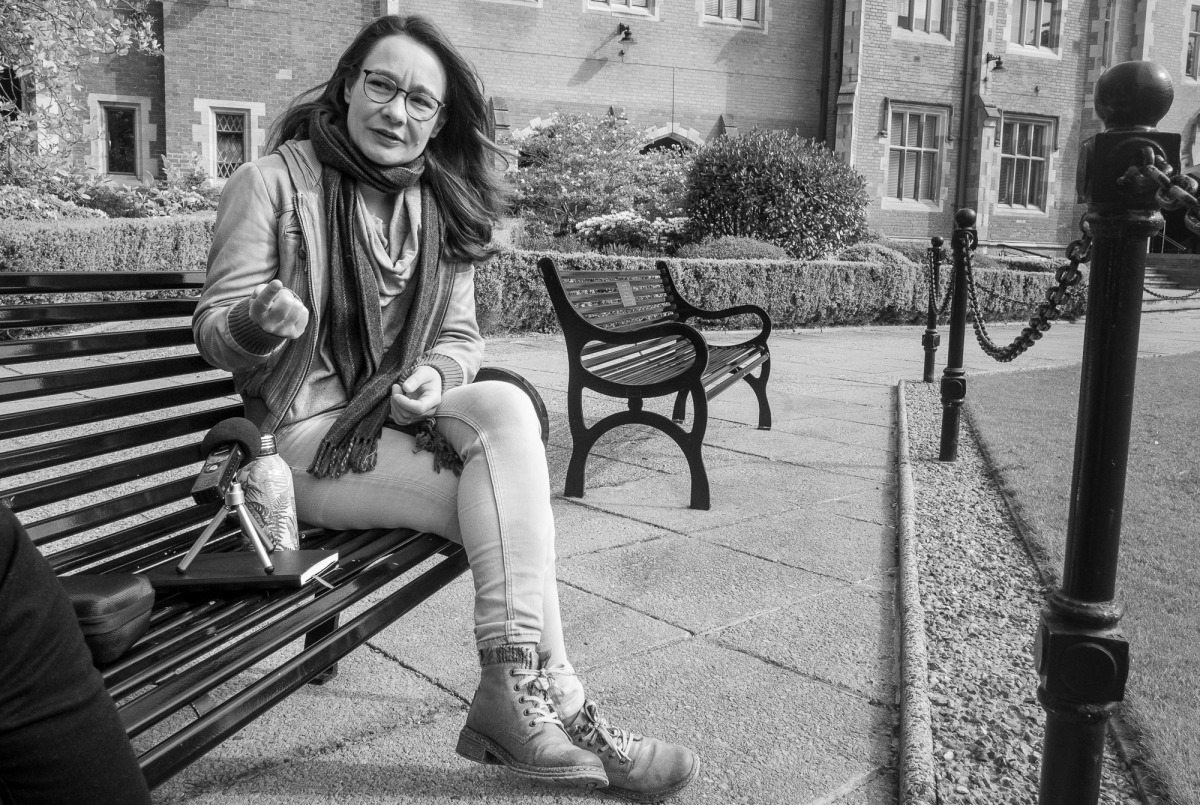
Katy Hayward at Queen’s University Belfast. ©Daniele Idini
On the other hand, Eileen Weir, Peacemaker and Community relations worker at Shankill Women’s Centre speaks of persistent social problems:
| “yeah, I think it is partly down to boredom. The things that people are not picking up on is that we have interface violence all year round. Right? This is not the first. They are usually not to that extreme where things are being burned or anything, but the two communities come together for a fight all year round and every year. We have a big, big drug problem in our communities and a lot of our young people are addicted to some type of drug, whether it’s illegal or prescribed. So we have a big mental health problem in our communities. It’s like they put a plaster on a thing that actually needs an operation. Our rate of suicide, and not just with young people with adults as well, is through the roof.” |

Eileen Weir in front of the Shankill Woman’s Centre. © Fellipe Lopes
Walking around the predominantly Protestant areas of Shankill and Lanark Way, as well as in the Catholic Springfield Road and Falls, reveals a tranquil environment with bustling local shops, active community centres and friendly characters, more than willing to share their views on the current situation.
These are among the areas of Belfast most affected by the long period of the Troubles and the scars are apparent. Chatting to locals from both communities living alongside the so-called the Cupar Way Peace-Wall the general impression is of a desire to leave behind a troubled past.

Shankill Road © Fellipe Lopes

Falls Road © Fellipe Lopes
According to Eileen:
| “we do have peaceful communities, OK? I mean, the woman that I work with, you know, we’re from North and West Belfast and we have a fantastic relationship. I don’t like to label anybody. But within that group I have Republicans, I have Nationalist, I have Loyalists, but building relationships is not enough. And we can all build relationships. But that relationship doesn’t happen overnight.” |

Clonard neighbourhood. © Fellipe Lopes

Shankill neighbourhood. © Daniele Idini
By Monday April 19th the moratorium on Loyalist protests in the wake of Prince Philip’s death had lapsed. That morning, in front of the Irish Secretariat, a two man protest against the Northern Irish Protocol, organised by the Loyalist Communities Council’s Chair David Campbell and former politician and co-founder of the group David McNarry, was in full swing.
Before long, however, it was interrupted by David McCord, whose brother Raymond was allegedly killed by members of the UVF in 1997. With a picture of his late brother in hand, he confronted the two men who were holding a banner that had appeared in different locations across Northern Ireland the previous night, addressed to the large media presence before them.
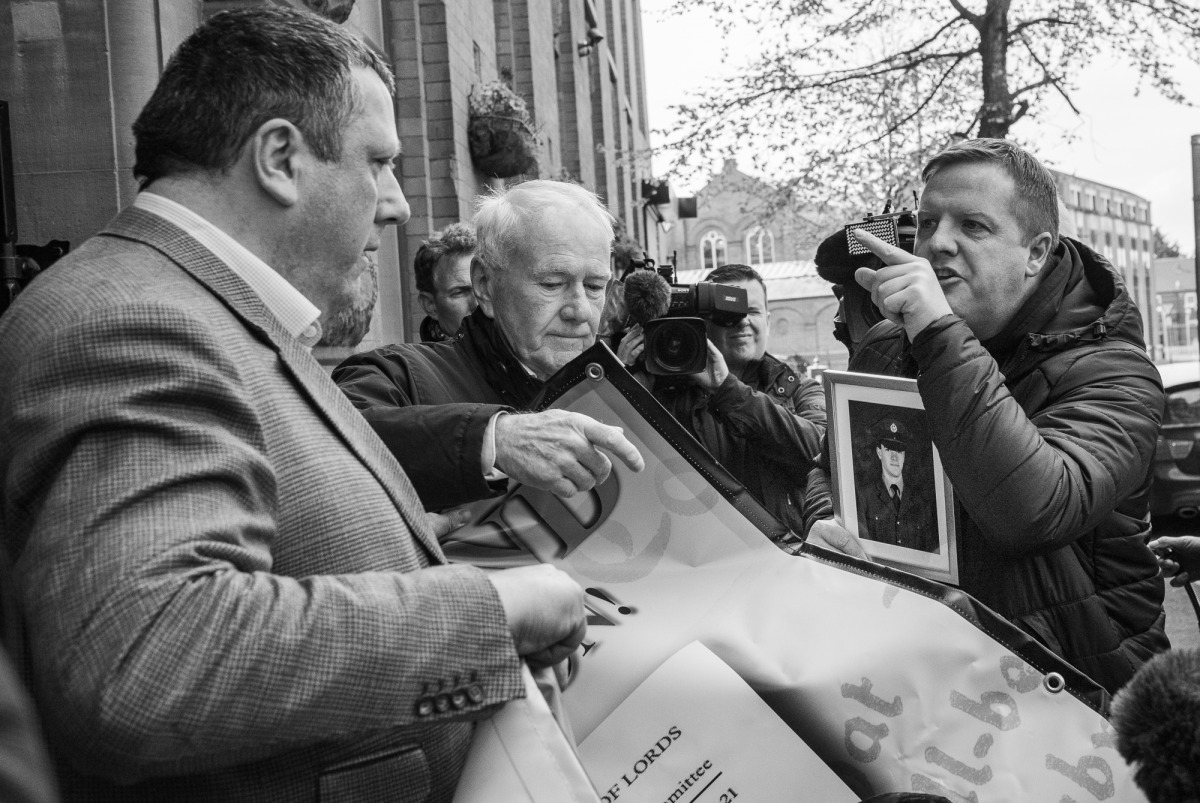
© Daniele Idini
There is a big gap between the government and these communities that reflects uncertainties over the decisions being made, especially the government’s failure to recognise the serious impact of their policies. Our conversations in the neighborhoods reveal a lack of understanding of the practical implications of Brexit and the Northern Ireland Protocol. This incoherence is reflected in the seemingly pointless violence.
Now there is particular concern around the escalating misbehaviour of teenagers, leading shop owners in the affected areas to coordinate closures.
Meanwhile on social media, calls to resume Anti-Northern Ireland Protocol protests across the region started to circulate. This included tweets about one to be held that evening at Lanark Way, where in previous weeks the violent riots had taken place.
In the hours leading up to the anticipated protests on Monday April 19th in the Springfield Road area, rumours circulated about community efforts to prevent local teenagers from taking part.

Springfield Road Interface. © Fellipe Lopes
But by that evening approximately thirty teenagers were blocking Lanark Way on the Shankill Road side, setting fire to furniture and rubbish in the middle of the street.
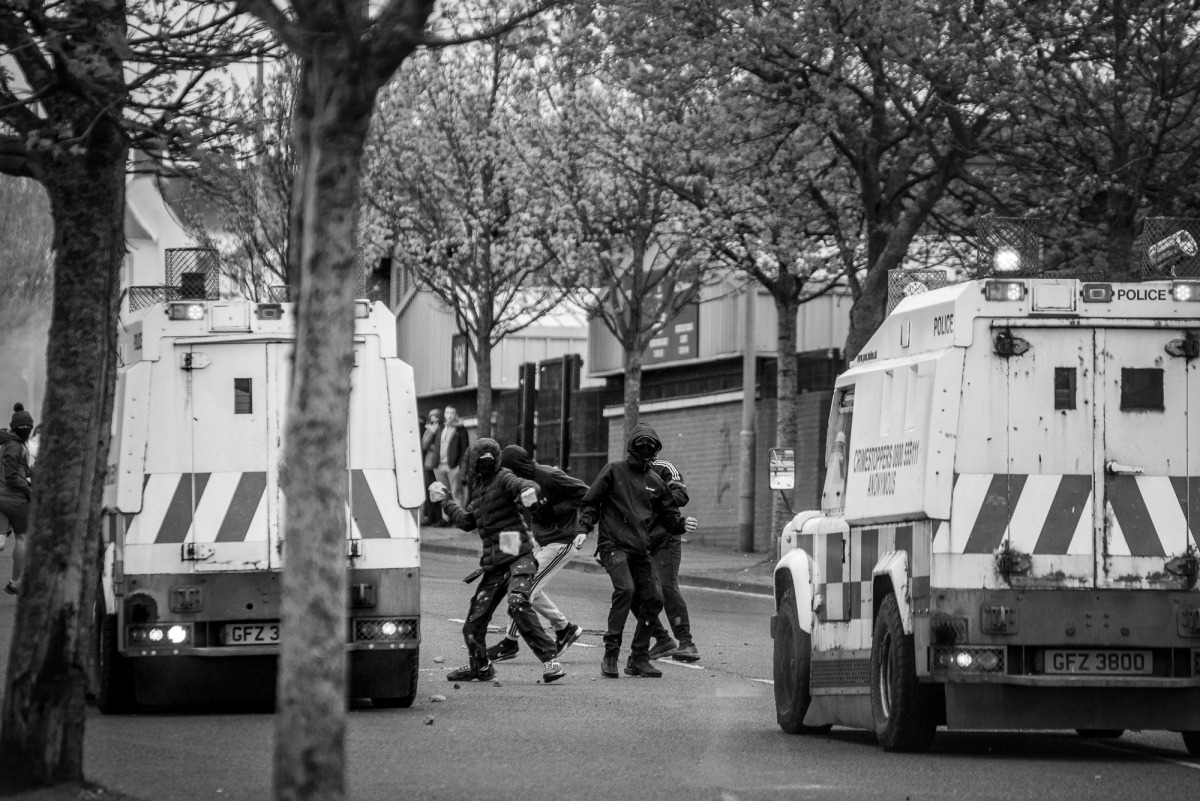
© Daniele Idini
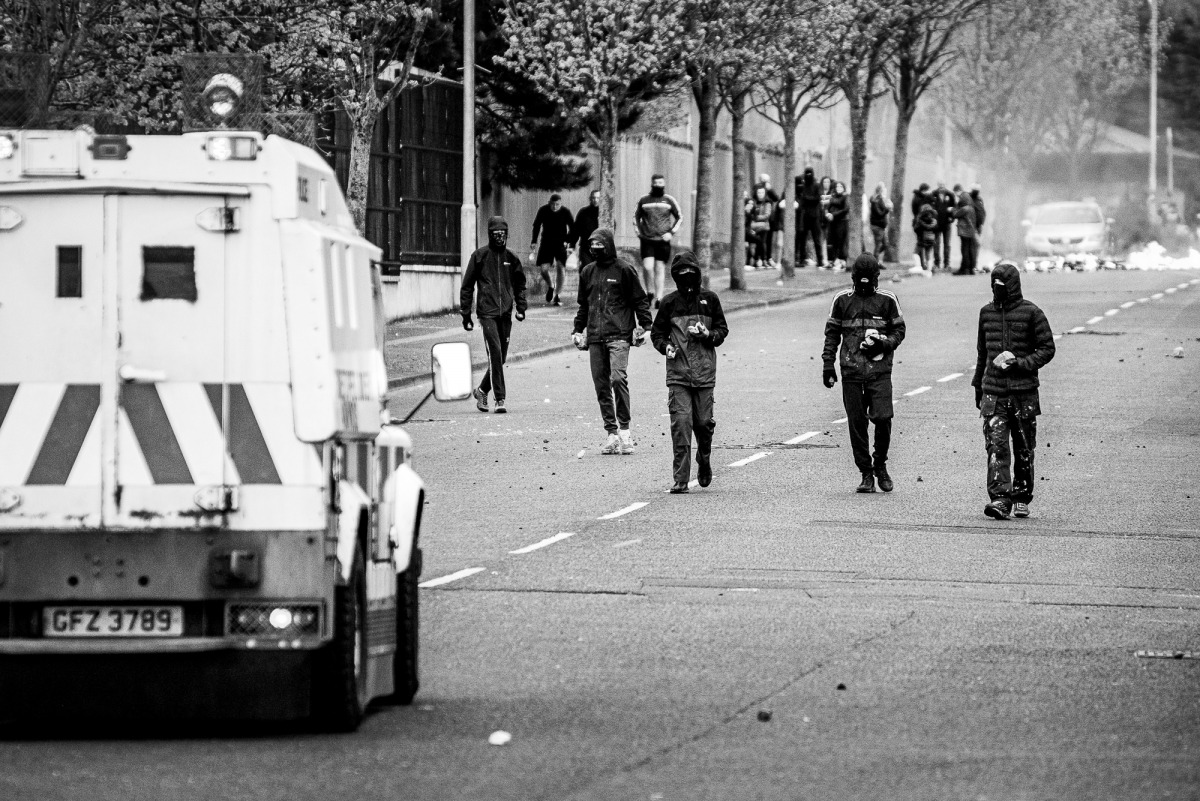
© Daniele Idini

© Fellipe Lopes

© Fellipe Lopes
The protest soon descended into stones and pieces of iron being thrown at police cars. Over the course of the disturbances we saw no visible expression of what was motivating the protesters; no posters criticizing the governments, or otherwise communicating reasons for the violence.
After a couple of hours, the PSNI asked journalists to leave the area and move to Springfield Road, as they closed the gate. This raises an important question as to what happens in the fight between teenagers and the police when media outlets are absent. A lack of media coverage fuels growing resentment towards the PSNI.
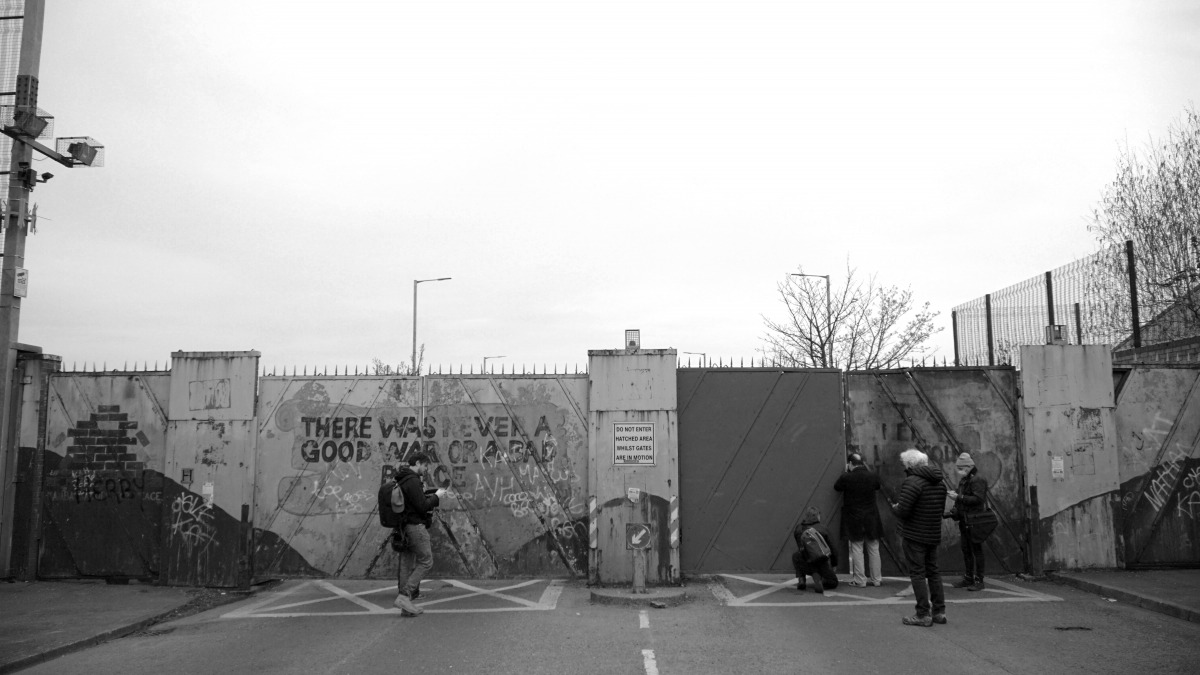
Lanark Way interface Gate © Fellipe Lopes
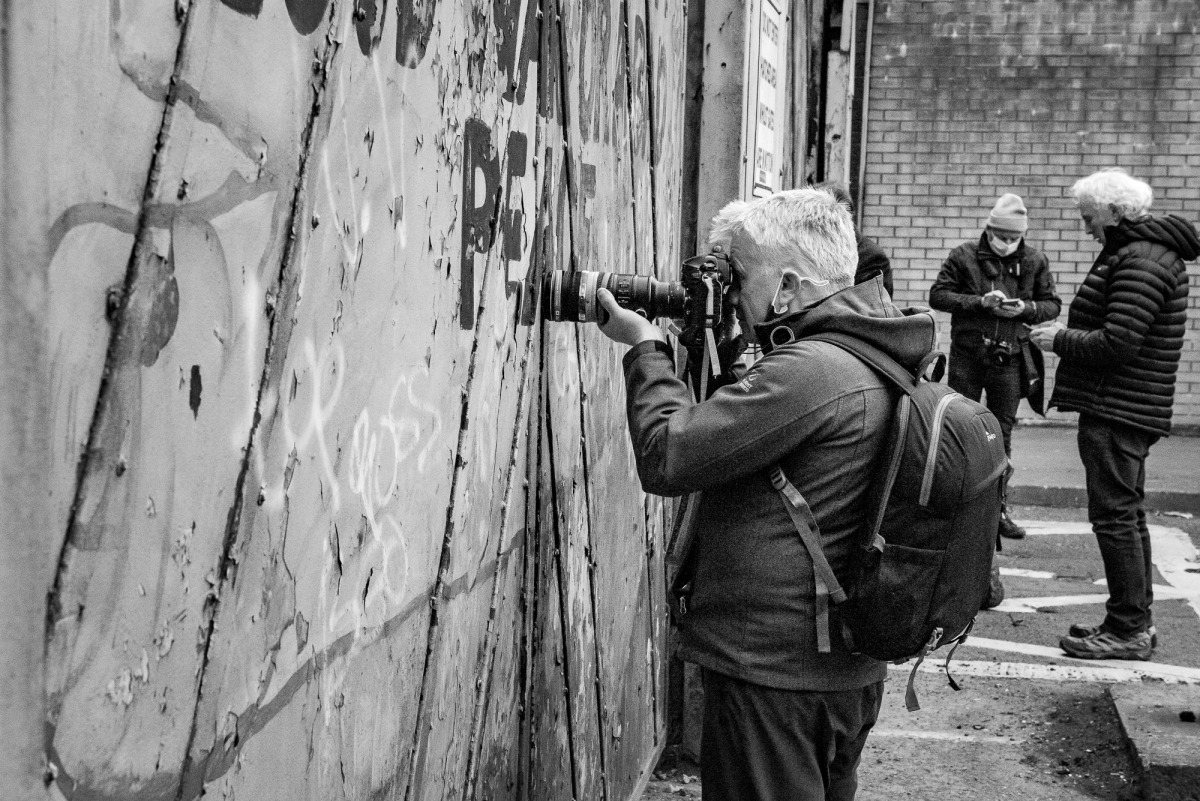
Lanark Way interface Gate. © Daniele Idini
Katy points to this new antipathy towards the PSNI:
| “you’ve had this new dimension, which is the criticism of the police service. That’s something very new. So for some time, Loyalists have been feeling that the police service no longer backs them … what changed in the past week was that the First Minister of Northern Ireland called on the chief constable to resign, and we had all the political leaders of Unionism calling for the same thing.” |

@ Fellipe Lopes
Katy adds:
| “They don’t trust political representatives or institutions to manage Northern Ireland’s interests. So you can see here all these factors exacerbating the sense of insecurity and that it only takes a few individuals. We know those individuals who have been present for a long time, presenting the Peace Process, presenting the compromise, thinking that violence pays. There’s a new narrative in Loyalism now that looks at what happens with the Protocol … They say the threat of Republican violence led to the Irish Sea border. So that’s another element.” |
Another important dimension is the difficulty faced by women in particular during the pandemic, as Eileen puts it:
| “the reason why this impacts on women more so is that there is homeschooling – working from home and often caring for an elderly relative. A lot of women’s jobs are low paid … zero hours contracts. We get very little recognition for the work of women. In the present situation, if it wasn’t for community workers being on the ground, you’d be seeing a hell of a lot more problems. And really, that’s not what community workers are for. That’s what our political representatives are for.“ |

Eileen Weir. © Fellipe Lopes
We also raised the question of a United Ireland and whether it is healthy to talk about this now. Katy said:
| “the more you talk about it, the more unnerving it is for Unionism. And that’s perfectly understandable because, of course, it’s anathema to the Unionist identity and certainly that is a factor. Because Brexit has taken Northern Ireland outside of the European Union, that’s a bereavement for some people and particularly for Nationalists. Northern Ireland is on the wrong side of that European external border, but that’s kind of overlooked because that leads to, certainly amongst Nationalists, a growing desire for Irish unity. They wish to see that happen and happen soon. But that has increased the uncertainty and insecurity for Unionists and we have both communities feeling more insecure in their position, thinking that the other is secure because basically they got what they wanted. ” |
Unsurprisingly, John holds a different view:
| “I personally think that the best outcome is a Northern Ireland that is part of the United Kingdom, but that has a close relationship with the Republic of Ireland. People here who identify as Irish have got free movement between the North and the South. They can work anywhere in Ireland and celebrate their Irishness and vice versa. There is good things in the British system and good things in the Irish system.” |

The Cupar Way ‘Peace Wall’. © Daniele Idini
Right now there is considerable focus on the decisions that the governments are making. The other part is about the lives and futures of these teenagers. Several communities in Belfast have paid a high price for the lack of access to education and job opportunities. Teenagers are now paying this bill. With their futures appearing bleak many have been drawn into unsuitable activities.
Discussion of the protest should look beyond the intricacies of the Brexit deal and the Northern Ireland Protocol. Society and government should be forming a long-term plan for the social and cultural integration.
On the streets you see violence involving teenagers and a decisive response from the police. What we did not discover is whether external forces are guiding and supporting these teenagers. Perhaps the real question is who stands to gain from the disorder?
These communities are experiencing challenges very similar to what happened from the 1960s to the 1990s. The Good Friday Agreement created peace, but the record player is still playing the same scratched tune, with an extraordinary new phenomenon at play, which is the pandemic.
The response of these adolescents represents another side to the impact of the pandemic. Mental health problems present as an issue in the lives of many families. The social projects around the Shankill and Falls Road do their best, but at this point the government has a responsibility to intervene, not only through policing, but also with social supports, inclusion programmes, enhanced access to education, job opportunities, improved living conditions and greater support for social workers, and psychologists.
The pandemic is leaving a distinct legacy in Belfast: the ashes from the street bonfires; the stones hurled at police and journalists, and a new generation of teenagers accustomed to fighting the police. But the locals we spoke to all want peace and integration. They don’t want this generation to experience the same story as their parents.
The fear is reborn of a new chapter to the Troubles. What happened over the last few weeks in Belfast has reawakened fears in these communities. No doubt this is a political issue, but the psychological scars are borne by individuals, families and communities.
You can support Cassandra Voices reporting either on an ongoing basis through Patreon or a one-off PayPal donation to [email protected].

© Fellipe Lopes

